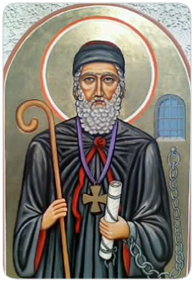Mar Abba the Great | |
|---|---|
 Mar Abba the Great Patriarch of Seleucia-Ctesiphon | |
| Catholicos Patriarch | |
| Born | Hala, Asorestan, Sasanid Iran |
| Died | 552 Adurbadagan, Sasanid Iran |
| Venerated in | Assyrian Church of the East Ancient Church of the East Chaldean Catholic Church Syro-Malabar Catholic Church |
| Major shrine | The Seminary of Mar Abba the Great El Cajon, California, United States |
Aba I (or, with his Syriac honorific, Mar Aba I) or Mar Abba the Great was the Patriarch of the Church of the East at Seleucia-Ctesiphon from 540 to 552. [1] He introduced to the church the anaphoras of Theodore of Mopsuestia and Nestorius beside the more ancient liturgical rite of Addai and Mari. [2] Though his tenure as catholicos saw Christians in the region threatened during the Persian-Roman wars and attempts by both Sassanid Persian and Byzantine rulers to interfere with the governance of the church, his reign is reckoned a period of consolidation, [3] and a synod he held in 544 as (despite excluding the Diocese of Merv) instrumental in unifying and strengthening the church. [4] In 544, the Synod of Mar Aba I adopted the ordinances of the Council of Chalcedon. [5] He is thought to have written and translated a number of religious works. [3] [6] After his death in February 552, the faithful carried his casket from his simple home across the Tigris to the monastery of Mar Pithyon.
Contents
Aba is a highly regarded and significantly venerated saint in the Assyrian Church of the East, the Ancient Church of the East, and the Chaldean Catholic Church. [7] He is documented in the Ausgewählte Akten Persischer Märtyrer , and The Lesser Eastern Churches , two biographies of Eastern saints. The first seminary of the Chaldean Catholic Church outside of Iraq was established in July 2008 in El Cajon, San Diego, as the Seminary of Mar Abba the Great.